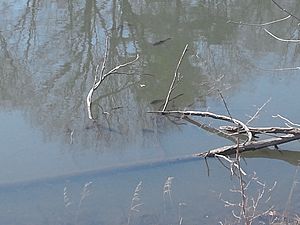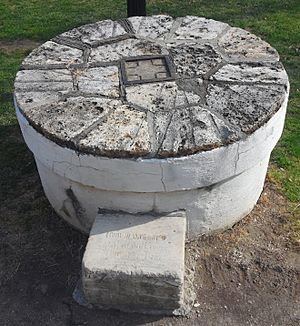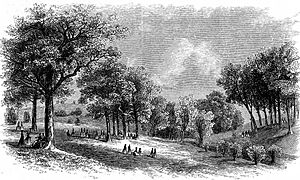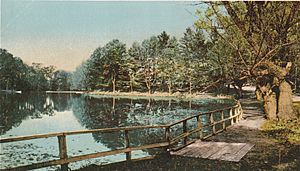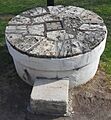Fonteyn Kill facts for kids
Quick facts for kids Fonteyn Kill |
|
|---|---|
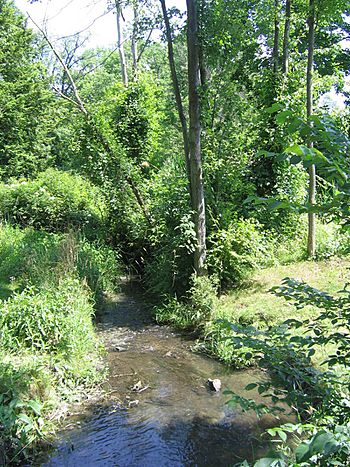
The Fonteyn Kill near its confluence with the Casperkill in June 2007
|
|
| Other name(s) | Fonteynkill, Fountain Kill, Mill Cove Brook |
| Physical characteristics | |
| Main source | Unknown, flows from a culvert beneath Park Avenue 41°41′20″N 73°54′22″W / 41.68898°N 73.90618°W |
| River mouth | Casperkill 41°40′59″N 73°53′36″W / 41.6830800°N 73.8932900°W |
| Length | 1.5 km (0.93 mi) |
| Basin features | |
| Progression | Casperkill, Hudson River |
| Waterbodies | Vassar Lake |
The Fonteyn Kill is a small stream, about 1.5-kilometer-long (0.93 mi), that flows through Dutchess County, New York. It runs onto the campus of Vassar College and then into the Casperkill. The stream's name comes from the Dutch words for "Spring Brook."
Long ago, the native Wappinger people lived on this land. Later, the Dutch and then the British took control. A mill was built along the stream by 1714. The stream was important to Matthew Vassar when he chose the location for his college. The man-made Vassar Lake is in the middle of the Fonteyn Kill. It was once used for ice skating and boating.
Even though the stream was once very clean, it now faces challenges. This is partly because of all the paved surfaces, like roads, in the area. These surfaces don't let water soak into the ground. The stream's bottom has many cobbles (round stones). It is home to tiny water creatures, trees, fish, birds, snapping turtles, and frogs. Since 2016, Vassar College and Cornell University have been working together to check the stream's water quality.
Contents
The Stream's Path
The Fonteyn Kill is about 1.5 kilometers (0.93 mi) long. In 1924, a historian named Helen Wilkinson Reynolds said the stream started from a spring in Arlington, New York. Today, its exact starting point is not known.
A study in 2010 showed that the Fonteyn Kill flows from a culvert (a tunnel for water) under Park Avenue. It goes east through a city area. Then it turns south and flows into the man-made Vassar Lake. From there, it moves southeast under Raymond Avenue. It passes through the Vassar College campus and under the college's Bridge for Laboratory Sciences. Finally, it flows into the Casperkill near Sunset Lake. This spot was once called "The Meeting of the Waters."
The Fonteyn Kill is the only stream that flows all year into the Casperkill. The Casperkill then flows into the Hudson River. In 1924, people noted that the Fonteyn Kill had several small branches. These were mostly "small meadow-runs" made of surface water.
Water Quality and the Environment
In the past, the Fonteyn Kill was known for its clean water. An 1867 book even called its waters "pellucid," meaning perfectly clear. However, the stream now suffers from what is called "urban stream syndrome." This means it has problems often seen in streams that flow through cities.
The areas around the Fonteyn Kill have many impervious surfaces. These are hard surfaces like roads and buildings that don't let water soak into the ground. Over 60% of the city area that drains into the stream is covered by these surfaces. This means a lot of storm drainage, or rainwater runoff, flows directly into the stream. Even so, the stream is surrounded by homes and wooded areas. On Vassar's campus, the stream runs along the 4-acre (1.6 ha) Edith Roberts Ecological Laboratory. It also passes the school's Shakespeare Garden.
A 2010 study found that the Fonteyn Kill had high levels of dissolved road salt. This was higher than any amount found in the Casperkill. Another study showed that areas upstream of Vassar Lake had twice as much salt as areas downstream. This suggests that Vassar Lake helps to mix and hold the water, which reduces the salt levels.
Scientists also use a special score called the Hilsenhoff family biotic index (HBI). This score measures how healthy the water is based on the types of tiny creatures living in it. A score of about six for the Fonteyn Kill means the water quality is "fairly poor." This suggests there might be some pollution.
In 2015, there were reports of a sewage leak in the stream. This led to high levels of bacteria. The New York State Department of Environmental Conservation (DEC) investigated and cleaned up the problem. In 2016, an oil spill was also seen. The DEC used special floating barriers called booms to soak up the oil.
To keep the stream healthy, Vassar College and Cornell University are working together. They regularly test the water at three different spots. They also count the tiny creatures living in the stream. This helps them understand the stream's health.
Land and Rocks
The land under the Fonteyn Kill has old rocks, like dolomite and shale. About 15,000 to 20,000 years ago, a glacial lake covered this area. Today, the land is covered by Till (a mix of clay, sand, gravel, and boulders left by glaciers). The stream's bottom is made of about 75% cobbles (round stones) and 25% sand, silt, and clay.
The area around the stream is fairly flat. The stream drops about 6.1–9.1 meters (20–30 ft) over its entire length. Vassar Lake, where the stream flows through, is not very deep. In 2013, its deepest point was about 1.8 meters (5 ft 11 in), and its average depth was 0.55 meters (1 ft 10 in).
Animals and Plants
The Fonteyn Kill and the land along its banks are home to many different plants and animals. In 2010, scientists found creatures like caddisflies, clams, mussels, crayfish, and different types of snails in the stream.
Trees growing along the stream include American elms, sugar maples, black cherries, and Norway maples. Shrubs like barberry, privet, and honeysuckle also grow there. You might also see Carp, mallards, great blue herons, frogs, snapping turtles, and other birds around the stream. In 1924, people used to fish for trout in the kill.
History of the Fonteyn Kill
The Fonteyn Kill flows through land that was first home to the Wappinger people. In the 1600s, the Dutch took control of the area, but then the British took it in 1664. Dutchess County was created.
A mill was built along the stream before 1714. This mill changed owners several times. In 1854, Matthew Vassar bought the land. He thought the clean water from the stream was very important for choosing where to build his college. In 1861, when Vassar College was founded, the land became part of the college. Today, a millstone from the old Fonteyn Kill mill is on display at Vassar College.
As Vassar College grew, more buildings were put up around the Fonteyn Kill. The old mill became the college's pumping station, which could pump 20,000 US gallons (76,000 L; 17,000 imp gal) of water every day. An ice house was also built near the stream by 1867. In winter, ice was cut from Vassar Lake and used to keep food cold in the college's Main Building.
In 1916, the college created its Shakespeare Garden. This garden used seeds from plants mentioned in William Shakespeare's plays. Later, in the 1920s and 1930s, the Edith Roberts Environmental Laboratory was built near the stream. More recently, the college built Olmsted Hall in 1972 and the Bridge for Laboratory Sciences, which opened in 2016.
What's in a Name?
The name "Fonteyn Kill" comes from the Dutch words Fonteyn Kil, which means "Spring Brook." Sometimes, the name is written as "Fonteynkill" without a space. It was also known as Fountain Kill, which is a mix of English and Dutch. In the 1800s, it was sometimes called Mill Cove Brook. The official name, Fonteyn Kill, was decided by the United States Board on Geographic Names in 2016.
Fun and Recreation
Since Vassar College was founded in the 1860s, the Fonteyn Kill and Vassar Lake have been used for fun activities. In 1867, Benson John Lossing wrote that Vassar students used Vassar Lake, then called "Mill Cove Lake," for rowing and boating in the summer. They even had a simple dock.
In the winter, when the lake froze, students would go ice skating on it. However, the lake was quite shallow, which made it harder for recreation. While some suggested making the lake deeper or even removing it, these ideas were not carried out. Today, the lake is no longer a main spot for recreation. In the 1920s and 1930s, the stream's source spring was sometimes blocked in winter. This would flood a nearby area, creating a pond for ice skating.
Images for kids



